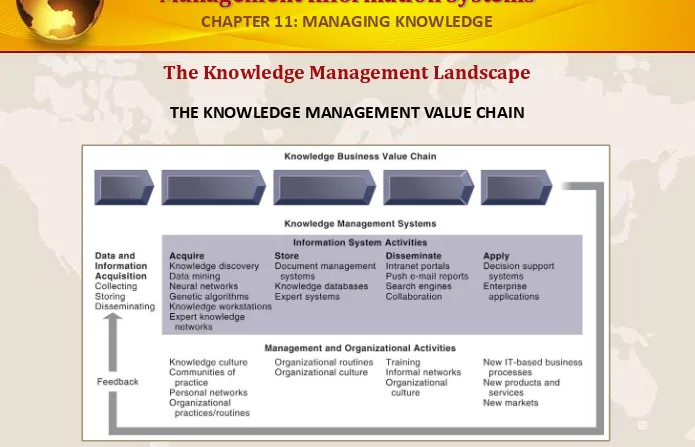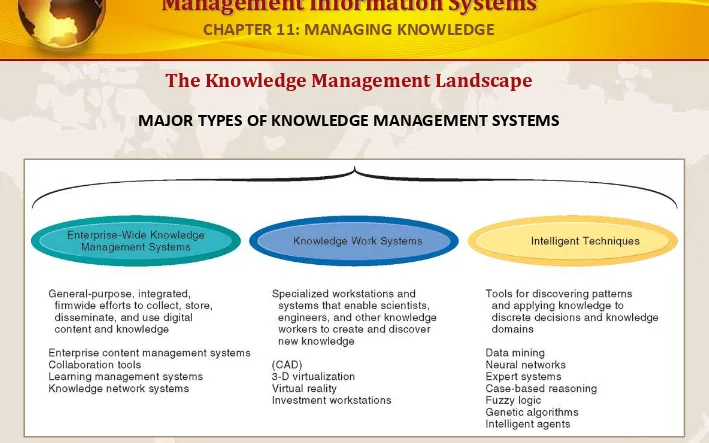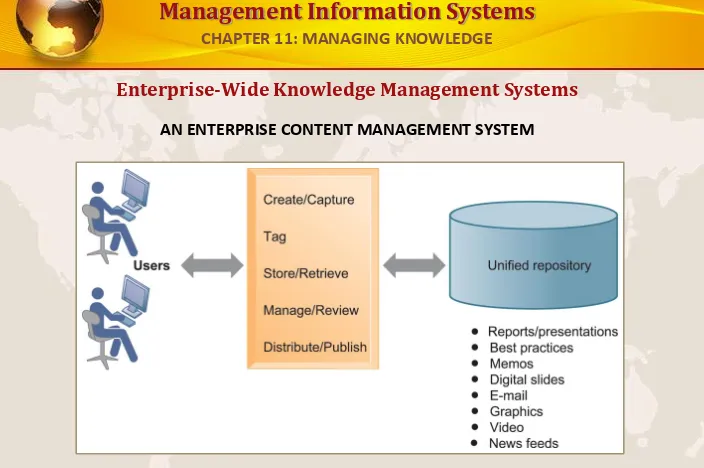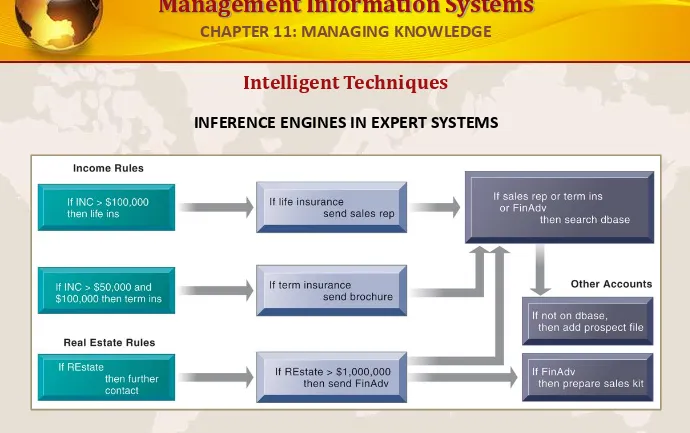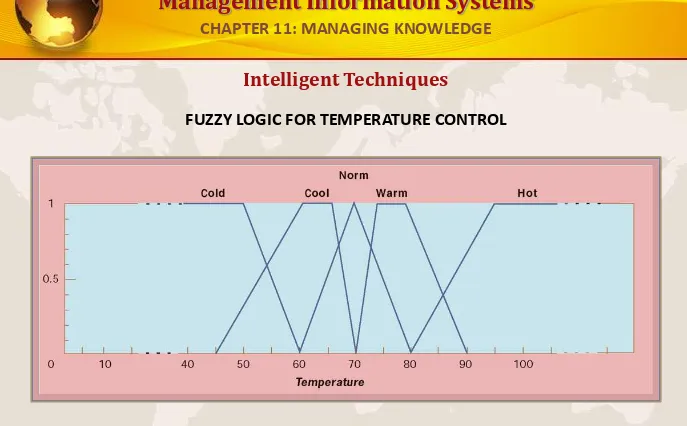Management Information Systems
MANAGING THE DIGITAL FIRM, 12THEDITION GLOBAL EDITION
MANAGING KNOWLEDGE
Chapter 11
VIDEO CASES
Management Information Systems
•
What is the role of knowledge management and
knowledge management programs in business?
•
What types of systems are used for enterprise-wide
knowledge management and how do they provide
value for businesses?
•
What are the major types of knowledge work
systems and how do they provide value for firms?
•
What are the business benefits of using intelligent
techniques for knowledge management?
Learning Objectives
Management Information Systems
• Problem: Document-intensive research and development dependent on paper records
• Solutions: Electronic document management system stores research information digitally
• eLab Notebook documentum management software creates PDFs, enables digital signatures, embeds usage rights,
enables digital searching of library
• Demonstrates IT’s role in reducing cost by making
organizational knowledge more easily available
• Illustrates how an organization can become more efficient
P&G Moves from Paper to Pixels for Knowledge Management
Management Information Systems
•
Knowledge management systems among fastest
growing areas of software investment
•
Information economy
– 55% U.S. labor force: knowledge and information workers – 60% U.S. GDP from knowledge and information sectors
•
Substantial part of a firm’s stock market value is
related to intangible assets: knowledge, brands,
reputations, and unique business processes
•
Well-executed knowledge-based projects can
produce extraordinary ROI
The Knowledge Management Landscape
Management Information Systems
•
Important dimensions of knowledge
–
Knowledge is a firm asset
• Intangible
• Creation of knowledge from data, information, requires organizational resources
• As it is shared, experiences network effects
–
Knowledge has different forms
• May be explicit (documented) or tacit (residing in minds) • Know-how, craft, skill
• How to follow procedure
The Knowledge Management Landscape
Management Information Systems
•
Important dimensions of knowledge (cont.)
–
Knowledge has a location
• Cognitive event
• Both social and individual
• “Sticky” (hard to move), situated (enmeshed in firm’s
culture), contextual (works only in certain situations)
–
Knowledge is situational
• Conditional: Knowing when to apply procedure
• Contextual: Knowing circumstances to use certain tool
The Knowledge Management Landscape
Management Information Systems
•
To transform information into knowledge, firm must
expend additional resources to discover patterns,
rules, and contexts where knowledge works
•
Wisdom:
– Collective and individual experience of applying knowledge to solve problems
– Involves where, when, and how to apply knowledge
•
Knowing how to do things effectively and efficiently
in ways others cannot duplicate is prime source of
profit and competitive advantage
The Knowledge Management Landscape
Management Information Systems
•
Organizational learning
–
Process in which organizations learn
•
Gain experience through collection of
data, measurement, trial and error, and
feedback
•
Adjust behavior to reflect experience
–
Create new business processes
–
Change patterns of management decision
making
The Knowledge Management Landscape
Management Information Systems
•
Knowledge management: Set of business processes
developed in an organization to create, store,
transfer, and apply knowledge
•
Knowledge management value chain:
–
Each stage adds value to raw data and information as
they are transformed into usable knowledge
1. Knowledge acquisition
2. Knowledge storage
3. Knowledge dissemination
The Knowledge Management Landscape
Management Information Systems
•
Knowledge management value chain
1. Knowledge acquisition
•
Documenting tacit and explicit knowledge
– Storing documents, reports, presentations, best practices
– Unstructured documents (e.g., e-mails) – Developing online expert networks
•
Creating knowledge
•
Tracking data from TPS and external sources
The Knowledge Management LandscapeManagement Information Systems
•
Knowledge management value chain (cont.)
2. Knowledge storage
•
Databases
•
Document management systems
•
Role of management:
– Support development of planned knowledge storage systems
– Encourage development of corporate-wide schemas for indexing documents
– Reward employees for taking time to update and store documents properly
The Knowledge Management Landscape
Management Information Systems
•
Knowledge management value chain (cont.)
3. Knowledge dissemination
•
Portals
•
Push e-mail reports
•
Search engines
•
Collaboration tools
•
A deluge of information?
– Training programs, informal networks, and shared management experience help managers focus
attention on important information
The Knowledge Management Landscape
Management Information Systems
•
Knowledge management value chain (cont.)
4. Knowledge application
•
To provide return on investment, organizational
knowledge must become systematic part of
management decision making and become
situated in decision-support systems
– New business practices
– New products and services – New markets
The Knowledge Management Landscape
Management Information Systems
The Knowledge Management Landscape
THE KNOWLEDGE MANAGEMENT VALUE CHAIN
Knowledge management today involves both information systems activities and a host of enabling management and organizational activities.
FIGURE 11-1
Management Information Systems
•
New organizational roles and responsibilities
–
Chief knowledge officer executives
–
Dedicated staff / knowledge managers
–
Communities of practice (COPs)
• Informal social networks of professionals and
employees within and outside firm who have similar work-related activities and interests
• Activities include education, online newsletters, sharing experiences and techniques
• Facilitate reuse of knowledge, discussion •
The Knowledge Management Landscape
Management Information Systems
•
3 major types of knowledge management systems:
1. Enterprise-wide knowledge management systems
• General-purpose firm-wide efforts to collect, store, distribute, and apply digital content and knowledge
2. Knowledge work systems (KWS)
• Specialized systems built for engineers, scientists, other knowledge workers charged with discovering and
creating new knowledge
3. Intelligent techniques
• Diverse group of techniques such as data mining used for various goals: discovering knowledge, distilling
knowledge, discovering optimal solutions
The Knowledge Management Landscape
Management Information Systems
The Knowledge Management Landscape
MAJOR TYPES OF KNOWLEDGE MANAGEMENT SYSTEMS
Management Information Systems
•
Three major types of knowledge in enterprise
1. Structured documents
• Reports, presentations • Formal rules
2. Semistructured documents
• E-mails, videos
3. Unstructured, tacit knowledge
•
80% of an organization’s business content is
semistructured or unstructured
Enterprise-Wide Knowledge Management Systems
Management Information Systems
•
Enterprise content management systems
–
Help capture, store, retrieve, distribute,
preserve
•
Documents, reports, best practices
•
Semistructured knowledge (e-mails)
–
Bring in external sources
•
News feeds, research
–
Tools for communication and collaboration
Enterprise-Wide Knowledge Management Systems
Management Information Systems
Enterprise-Wide Knowledge Management Systems
AN ENTERPRISE CONTENT MANAGEMENT SYSTEM
An enterprise content management system has capabilities for classifying, organizing, and managing structured and semistructured knowledge and making it available throughout the enterprise.
FIGURE 11-3
Management Information Systems
•
Enterprise content management systems
–
Key problem
–
Developing taxonomy
•
Knowledge objects must be tagged with
categories for retrieval
–
Digital asset management systems
•
Specialized content management systems for
classifying, storing, managing unstructured
digital data
•
Photographs, graphics, video, audio
Enterprise-Wide Knowledge Management Systems
Management Information Systems
•
Knowledge network systems
–
Provide online directory of corporate experts in
well-defined knowledge domains
–
Use communication technologies to make it easy
for employees to find appropriate expert in a
company
–
May systematize solutions developed by experts
and store them in knowledge database
•
Best-practices
•
Frequently asked questions (FAQ) repository
Enterprise-Wide Knowledge Management SystemsManagement Information Systems
Enterprise-Wide Knowledge Management Systems
AN ENTERPRISE KNOWLEDGE
NETWORK SYSTEM
A knowledge network maintains a database of firm experts, as well as accepted solutions to known problems, and then facilitates the communication between employees looking for
knowledge and experts who have that knowledge. Solutions created in this communication are then added to a database of solutions in the form of FAQs, best practices, or other documents.
FIGURE 11-4
Management Information Systems
•
Portal and collaboration technologies
–
Enterprise knowledge portals: Access to external
and internal information
• News feeds, research
• Capabilities for e-mail, chat, videoconferencing, discussion
–
Use of consumer Web technologies
• Blogs • Wikis
• Social bookmarking
Enterprise-Wide Knowledge Management Systems
Management Information Systems
•
Learning management systems
–
Provide tools for management, delivery, tracking,
and assessment of various types of employee
learning and training
–
Support multiple modes of learning
• CD-ROM, Web-based classes, online forums, live instruction, etc.
–
Automates selection and administration of courses
–
Assembles and delivers learning content
–
Measures learning effectiveness
Enterprise-Wide Knowledge Management Systems
Management Information Systems
•
Knowledge work systems
– Systems for knowledge workers to help create new knowledge and integrate that knowledge into business
•
Knowledge workers
– Researchers, designers, architects, scientists, engineers who create knowledge for the organization
– Three key roles:
1. Keeping organization current in knowledge
2. Serving as internal consultants regarding their areas of expertise
3. Acting as change agents, evaluating, initiating, and promoting change projects
Knowledge Work Systems
Management Information Systems
•
Requirements of knowledge work systems
–
Substantial computing power for graphics,
complex calculations
–
Powerful graphics and analytical tools
–
Communications and document management
–
Access to external databases
–
User-friendly interfaces
–
Optimized for tasks to be performed (design
engineering, financial analysis)
Knowledge Work Systems
Management Information Systems
Knowledge Work Systems
REQUIREMENTS OF KNOWLEDGE WORK SYSTEMS
Knowledge work systems require strong links to external knowledge bases in addition to specialized hardware and software.
FIGURE 11-5
Management Information Systems
•
Examples of knowledge work systems
–
CAD (computer-aided design):
• Creation of engineering or architectural designs
–
Virtual reality systems:
• Simulate real-life environments
• 3-D medical modeling for surgeons • Augmented reality (AR) systems • VRML
–
Investment workstations:
• Streamline investment process and consolidate
internal, external data for brokers, traders, portfolio
Knowledge Work Systems
Management Information Systems
Read the Interactive Session and discuss the following questions
•
What is the difference between virtual reality and
augmented reality?
•
Why is augmented reality so appealing to
marketers?
•
What makes augmented reality useful for real
estate shopping applications?
•
Suggest some other knowledge work applications
for augmented reality
Knowledge Work Systems
AUGMENTED REALITY: REALITY GETS BETTER
Management Information Systems
•
Intelligent techniques:
Used to capture individual
and collective knowledge and to extend knowledge
base
– To capture tacit knowledge: Expert systems, case-based reasoning, fuzzy logic
– Knowledge discovery: Neural networks and data mining – Generating solutions to complex problems: Genetic
algorithms
– Automating tasks: Intelligent agents
•
Artificial intelligence (AI) technology:
– Computer-based systems that emulate human behavior
Intelligent Techniques
Management Information Systems
•
Expert systems:
–
Capture tacit knowledge in very specific and limited
domain of human expertise
–
Capture knowledge of skilled employees as set of
rules in software system that can be used by others
in organization
–
Typically perform limited tasks that may take a few
minutes or hours, e.g.:
• Diagnosing malfunctioning machine
• Determining whether to grant credit for loan
–
Used for discrete, highly structured decision-making
Intelligent Techniques
Management Information Systems
Intelligent Techniques
RULES IN AN EXPERT SYSTEM
An expert system contains a number of rules to be followed. The rules are interconnected; the number of outcomes is known in advance and is limited; there are multiple paths to the same
outcome; and the system can consider multiple rules at a single time. The rules illustrated are for simple credit-granting expert systems.
FIGURE 11-6
Management Information Systems
•
How expert systems work
–
Knowledge base: Set of hundreds or thousands of
rules
–
Inference engine: Strategy used to search knowledge
base
• Forward chaining: Inference engine begins with
information entered by user and searches knowledge base to arrive at conclusion
• Backward chaining: Begins with hypothesis and asks user questions until hypothesis is confirmed or
disproved
Intelligent Techniques
Management Information Systems
Intelligent Techniques
INFERENCE ENGINES IN EXPERT SYSTEMS
An inference engine works by searching through the rules and “firing” those rules that are triggered by facts
gathered and entered by the user. Basically, a collection of rules is similar to a series of nested IF statements FIGURE 11-7
Management Information Systems
•
Successful expert systems
– Con-Way Transportation built expert system to automate and optimize planning of overnight shipment routes for nationwide freight-trucking business
•
Most expert systems deal with problems of
classification
– Have relatively few alternative outcomes – Possible outcomes are known in advance
•
Many expert systems require large, lengthy, and
expensive development and maintenance efforts
– Hiring or training more experts may be less expensive
Intelligent Techniques
Management Information Systems
•
Case-based reasoning (CBR)
– Descriptions of past experiences of human specialists (cases), stored in knowledge base
– System searches for cases with problem characteristics similar to new one, finds closest fit, and applies solutions of old case to new case
– Successful and unsuccessful applications are grouped with case
– Stores organizational intelligence: Knowledge base is continuously expanded and refined by users
– CBR found in
• Medical diagnostic systems
Intelligent Techniques
Management Information Systems
Intelligent Techniques
HOW CASE-BASED REASONING WORKS
Case-based reasoning represents knowledge as a database of past cases and their solutions. The system uses a six-step process to generate solutions to new problems encountered by the user.
FIGURE 11-8
Management Information Systems
•
Fuzzy logic systems
– Rule-based technology that represents imprecision used
in linguistic categories (e.g., “cold,” “cool”) that represent
range of values
– Describe a particular phenomenon or process
linguistically and then represent that description in a small number of flexible rules
– Provides solutions to problems requiring expertise that is difficult to represent with IF-THEN rules
• Autofocus in cameras
• Detecting possible medical fraud
Intelligent Techniques
Management Information Systems
Intelligent Techniques
FUZZY LOGIC FOR TEMPERATURE CONTROL
The membership functions for the input called temperature are in the logic of the thermostat to control the room temperature. Membership functions help translate linguistic expressions such as warm into numbers that the computer can manipulate.
FIGURE 11-9
Management Information Systems
•
Neural networks
– Find patterns and relationships in massive amounts of data too complicated for humans to analyze
– “Learn” patterns by searching for relationships, building
models, and correcting over and over again
– Humans “train” network by feeding it data inputs for which
outputs are known, to help neural network learn solution by example
– Used in medicine, science, and business for problems in
pattern classification, prediction, financial analysis, and control and optimization
– Machine learning: Related AI technology allowing computers to learn by extracting information using computation and statistical
Intelligent Techniques
Management Information Systems
Read the Interactive Session and discuss the following questions
•
Describe the system that Albassami uses to ship
clients’ cars .
•
What kind of valuable information does the system
provide?
•
How did implementing the Shipping Information
System address the needs of Albassami?
Intelligent Techniques
ALBASSAMI’S JOB IS NOT FEASIBLE WITHOUT I.T.
Management Information Systems
Intelligent Techniques
HOW A NEURAL NETWORK WORKS
A neural network uses rules it “learns” from patterns in data to construct a hidden layer of logic. The hidden
FIGURE 11-10
Management Information Systems
•
Genetic algorithms
– Useful for finding optimal solution for specific problem by examining very large number of possible solutions for
that problem
– Conceptually based on process of evolution
• Search among solution variables by changing and
reorganizing component parts using processes such as inheritance, mutation, and selection
– Used in optimization problems (minimization of costs, efficient scheduling, optimal jet engine design) in which hundreds or thousands of variables exist
– Able to evaluate many solution alternatives quickly
Intelligent Techniques
Management Information Systems
Intelligent Techniques
THE COMPONENTS OF A GENETIC ALGORITHM
This example illustrates an initial population of “chromosomes,” each representing a different solution. The
FIGURE 11-11
Management Information Systems
•
Hybrid AI systems
–
Genetic algorithms, fuzzy logic, neural
networks, and expert systems integrated
into single application to take advantage
of best features of each
–
E.g., Matsushita “neurofuzzy” washing
machine that combines fuzzy logic with
neural networks
Intelligent Techniques
Management Information Systems
•
Intelligent agents
–
Work in background to carry out specific, repetitive,
and predictable tasks for user, process, or application
–
Use limited built-in or learned knowledge base to
accomplish tasks or make decisions on user’s behalf
• Deleting junk e-mail
• Finding cheapest airfare
–
Agent-based modeling applications:
• Systems of autonomous agents
• Model behavior of consumers, stock markets, and
Intelligent Techniques
Management Information Systems
Intelligent Techniques
INTELLIGENT AGENTS IN P&G’S SUPPLY CHAIN NETWORK
Intelligent agents are helping P&G shorten the replenishment cycles for products, such as a box of Tide. FIGURE 11-12
Management Information Systems
All rights reserved. No part of this publication may be reproduced, stored in a retrieval system, or transmitted, in any form or by any means, electronic, mechanical, photocopying, recording, or otherwise, without the
prior written permission of the publisher.
Printed in the United States of America.
Copyright © 2012 Pearson Education
Management Information Systems
MANAGING THE DIGITAL FIRM, 12THEDITION GLOBAL EDITION
ENHANCING DECISION MAKING
Chapter 12
VIDEO CASES
Case 1: Antivia: Community-based Collaborative Business Intelligence
Management Information Systems
• What are the different types of decisions and how does the
decision-making process work?
• How do information systems support the activities of
managers and management decision making?
• How do business intelligence and business analytics support
decision making?
• How do different decision-making constituencies in an
organization use business intelligence?
• What is the role of information systems in helping people
working in a group make decisions more efficiently?
Learning Objectives
Management Information Systems
•
Problem:
Chain retailers such as Starbucks, Duane
Reade, need to determine what products will sell at
what prices at different locations
•
Solutions:
Business analytics software to analyze
patterns in sales data, create pricing profiles and
buyer profiles for different regions, locales, even
times of day
•
Demonstrates the use of business intelligence and
analysis systems to improve sales and profits
•
Illustrates how information systems improve
decision making
What to Sell? What Price to Charge? Ask the Data
Management Information Systems
•
Business value of improved decision making
–
Improving hundreds of thousands of “small” decisions
adds up to large annual value for the business
•
Types of decisions:
–
Unstructured:
Decision maker must provide
judgment, evaluation, and insight to solve problem
–
Structured:
Repetitive and routine; involve definite
procedure for handling so they do not have to be
treated each time as new
–
Semistructured:
Only part of problem has clear-cut
Decision Making and Information Systems
Management Information Systems
•
Senior managers:
– Make many unstructured decisions
– E.g. Should we enter a new market?
•
Middle managers:
– Make more structured decisions but these may include unstructured components
– E.g. Why is order fulfillment report showing decline in Minneapolis?
•
Operational managers, rank and file employees
– Make more structured decisions
– E.g. Does customer meet criteria for credit?
Decision Making and Information Systems
Management Information Systems
Decision Making and Information Systems
INFORMATION REQUIREMENTS OF KEY DECISION-MAKING GROUPS IN A FIRM
Management Information Systems
•
The 4 stages of the decision making process
1. Intelligence
• Discovering, identifying, and understanding the problems occurring in the organization
2. Design
• Identifying and exploring solutions to the problem
3. Choice
• Choosing among solution alternatives
4. Implementation
• Making chosen alternative work and continuing to monitor how well solution is working
Decision Making and Information Systems
Management Information Systems
Decision Making and Information Systems
STAGES IN DECISION MAKING
The decision-making process is broken down into four stages.
FIGURE 12-2
Management Information Systems
•
Information systems can only assist in some of the
roles played by managers
•
Classical model of management: 5 functions
–
Planning, organizing, coordinating, deciding, and
controlling
•
More contemporary behavioral models
–
Actual behavior of managers appears to be less
systematic, more informal, less reflective, more
reactive, and less well organized than in classical
model
Decision Making and Information Systems
Management Information Systems
•
Mintzberg’s 10 managerial roles
–
Interpersonal roles
1. Figurehead 2. Leader
3. Liaison
–
Informational roles
4. Nerve center 5. Disseminator 6. Spokesperson
–
Decisional roles
7. Entrepreneur
8. Disturbance handler 9. Resource allocator
Decision Making and Information Systems
Management Information Systems
•
Three main reasons why investments in information
technology do not always produce positive results
1. Information quality
• High-quality decisions require high-quality information
2. Management filters
• Managers have selective attention and have variety of biases that reject information that does not conform to prior conceptions
3. Organizational inertia and politics
• Strong forces within organizations resist making decisions calling for major change
Decision Making and Information Systems
Management Information Systems
•
High velocity automated decision making
–
Made possible through computer algorithms
precisely defining steps for a highly structured
decision
–
Humans taken out of decision
–
E.g. High-speed computer trading programs
• Trades executed in 30 milliseconds • Responsible for “Flash Crash” of 2010
–
Require safeguards to ensure proper operation and
regulation
Decision Making and Information Systems
Management Information Systems
•
Business intelligence
–
Infrastructure for collecting, storing, analyzing data
produced by business
–
Databases, data warehouses, data marts
•
Business analytics
–
Tools and techniques for analyzing data
–
OLAP, statistics, models, data mining
•
Business intelligence vendors
–
Create business intelligence and analytics purchased
by firms
Business Intelligence in the Enterprise
Management Information Systems
•
Six elements in the business intelligence
environment
1. Data from the business environment
2. Business intelligence infrastructure
3. Business analytics toolset
4. Managerial users and methods
5. Delivery platform
–
MIS, DSS, ESS
6. User interface
Business Intelligence in the Enterprise
Management Information Systems
Business Intelligence in the Enterprise
BUSINESS INTELLIGENCE AND ANALYTICS FOR DECISION SUPPORT
Business intelligence and analytics requires a strong database foundation, a set of analytic tools, and an involved management team that can ask intelligent questions and analyze data.
FIGURE 12-3
Management Information Systems
•
Business intelligence and analytics capabilities
–
Goal is to deliver accurate real-time information to
decision-makers
–
Main functionalities of BI systems
1. Production reports
2. Parameterized reports 3. Dashboards/scorecards
4. Ad hoc query/search/report creation 5. Drill down
6. Forecasts, scenarios, models
Business Intelligence in the Enterprise
Management Information Systems
•
Business intelligence users
–
80% are casual users relying on production reports
–
Senior executives
• Use monitoring functionalities
–
Middle managers and analysts
• Ad-hoc analysis
–
Operational employees
• Prepackaged reports
• E.g. sales forecasts, customer satisfaction, loyalty and attrition, supply chain backlog, employee productivity
Business Intelligence in the Enterprise
Management Information Systems
Business Intelligence in the Enterprise
BUSINESS INTELLIGENCE USERS
Management Information Systems
•
Examples of BI applications
–
Predictive analytics
• Use patterns in data to predict future behavior
• E.g. Credit card companies use predictive analytics to determine customers at risk for leaving
–
Data visualization
• Help users see patterns and relationships that would be difficult to see in text lists
–
Geographic information systems (GIS)
• Ties location-related data to maps
Business Intelligence in the Enterprise
Management Information Systems
•
Management strategies for developing BI and BA
capabilities
–
Two main strategies
1. One-stop integrated solution
– Hardware firms sell software that run optimally on their hardware
– Makes firm dependent on single vendor – switching costs
2. Multiple best-of-breed solution
– Greater flexibility and independence
– Potential difficulties in integration
– Must deal with multiple vendors
Business Intelligence in the Enterprise
Management Information Systems
Read the Interactive Session and discuss the following questions
• Identify and describe the problem discussed in the case.
• How do business intelligence systems provide a solution to this problem? What are the inputs and outputs of these systems?
• What management, organization, and technology issues must be addressed by this solution?
• How successful is this solution? Explain your answer.
• Should all school districts use such a data-driven approach to education? Why or why not?
Business Intelligence in the Enterprise
DATA-DRIVEN SCHOOLS
Management Information Systems
•
Operational and middle managers
–
Monitor day to day business performance
–
Make fairly structured decisions
–
Use MIS
•
“Super user” and business analysts
–
Use more sophisticated analysis
–
Create customized reports
–
Use DSS
Business Intelligence Constituencies
Management Information Systems
•
Decision support systems
–
Use mathematical or analytical models
–
Allow varied types of analysis
•
“What
-
if” analysis
•
Sensitivity analysis
•
Backward sensitivity analysis
•
Multidimensional analysis / OLAP
–
E. g. pivot tables
Business Intelligence Constituencies
Management Information Systems
Business Intelligence Constituencies
SENSITIVITY ANALYSIS
This table displays the results of a sensitivity analysis of the effect of changing the sales price of a necktie
and the cost per unit on the product’s break-even point. It answers the question, “What happens to the break-even point if the sales price and the cost to make each unit increases or decreases?”
FIGURE 12-5
Management Information Systems
Business Intelligence Constituencies
A PIVOT TABLE THAT EXAMINES CUSTOMER REGIONAL
DISTRIBUTION AND ADVERTISING SOURCE
In this pivot table, we are able to examine where an online
training company’s
customers come from in terms of region and advertising source.
FIGURE 12-6
Management Information Systems
•
Decision-support for senior management
–
Help executives focus on important performance
information
–
Balanced scorecard method:
• Measures outcomes on four dimensions:
1. Financial
2. Business process
3. Customer
4. Learning & growth
• Key performance indicators (KPIs) measure each
Business Intelligence Constituencies
Management Information Systems
Business Intelligence Constituencies
THE BALANCED SCORECARD FRAMEWORK
In the balanced scorecard framework,
the firm’s strategic
objectives are
operationalized along four dimensions: financial, business process, customer, and learning and growth. Each dimension is measured using several KPIs.
FIGURE 12-7
Management Information Systems
•
Decision-support for senior management (cont.)
– Business performance management (BPM)
• Translates firm’s strategies (e.g. differentiation, low -cost producer, scope of operation) into operational targets
• KPIs developed to measure progress towards targets – Data for ESS
• Internal data from enterprise applications
• External data such as financial market databases •
Business Intelligence Constituencies
Management Information Systems
Read the Interactive Session and discuss the following questions
• What management, organization, and technology issues had to be
addressed when developing Valero’s dashboard?
• What measures of performance do the dashboards display? Give examples of several management decisions that would benefit
from the information provided by Valero’s dashboards.
• What kinds of information systems are required by Valero to maintain and operate its refining dashboard?
• How effective are Valero’s dashboards in helping management
pilot the company? Explain your answer.
• Should Valero develop a dashboard to measure the many factors in its environment that it does not control? Why or why not?
Business Intelligence Constituencies
PILOTING VALERO WITH REAL-TIME MANAGEMENT
Management Information Systems
•
Group Decision Support Systems (GDSS)
– Interactive system to facilitate solution of unstructured problems by group
– Specialized hardware and software; typically used in conference rooms
• Overhead projectors, display screens
• Software to collect, rank, edit participant ideas and responses
• May require facilitator and staff
– Enables increasing meeting size and increasing productivity
– Promotes collaborative atmosphere, guaranteeing anonymity
–
Business Intelligence Constituencies
Management Information Systems
All rights reserved. No part of this publication may be reproduced, stored in a retrieval system, or transmitted, in any form or by any means, electronic, mechanical, photocopying, recording, or otherwise, without the
prior written permission of the publisher.
Printed in the United States of America.
Copyright © 2012 Pearson Education
